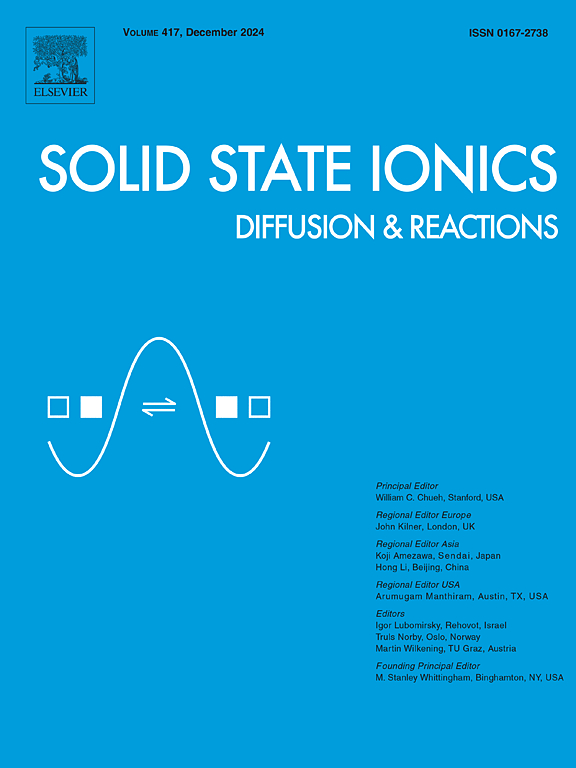Mixed-valence Sm-doped LaF3 crystals as ion-electron conductors: Crystal growth and impedance characterization
IF 3
4区 材料科学
Q3 CHEMISTRY, PHYSICAL
引用次数: 0
Abstract
The single crystals with the composition La1−y(Sm3+1−xSm2+x)yF3−xy (y = 0.04) were grown from melt by the vertical Bridgman technique. A part of the Sm3+ doping ions in LaF3 matrix is reduced to the Sm2+ oxidation state due to interaction with carbon during the growth process. The crystals were studied by X-ray diffraction analysis, optical and impedance spectroscopy. The Sm-doped crystals LaF3 are single-phase, retaining the tysonite-type structure (sp. gr. P-3c1) and demonstrate a bipolar electrical conductivity mechanism. Both the ionic conductivity σi = 4.7 × 10−5 S/cm caused by heterovalent substitutions of La3+ for Sm2+ and the comparable electronic conductivity σe = 3 × 10−5 S/cm due to the variable oxidation states Sm2+/Sm3+ ions were detected for the grown crystals. The discovered mixed ionic-electronic conductivity of La0.96Sm3+0.004Sm2+0.036F2.964 crystals opens up a new direction for the practical application of the tysonite-type fluorides as a component of electrode materials for fluorine-ion current sources.
作为离子电子导体的混合价掺杂 Sm 的 LaF3 晶体:晶体生长和阻抗表征
通过垂直布里奇曼技术从熔体中生长出了成分为 La1-y(Sm3+1-xSm2+x)yF3-xy La1-ySm1-x3+Smx2+yF3-xy(y = 0.04) 的单晶体。在生长过程中,由于与碳的相互作用,LaF3 基体中的部分 Sm3+ 掺杂离子被还原成 Sm2+ 氧化态。晶体通过 X 射线衍射分析、光学和阻抗光谱进行了研究。掺杂了 Sm 的晶体 LaF3 是单相的,保留了泰松石型结构(sp. gr. P-3c1P3̄c1),并显示了双极导电机制。在生长的晶体中,检测到了因 La3+ 对 Sm2+ 的异价取代而产生的离子电导率 σi = 4.7 × 10-5 S/cm,以及因 Sm2+/Sm3+ 离子的可变氧化态而产生的可比电子电导率 σe = 3 × 10-5 S/cm。所发现的 La0.96Sm3+0.004Sm2+0.036F2.964 晶体的离子-电子混合电导率为钛铁矿型氟化物作为氟离子电流源电极材料成分的实际应用开辟了新的方向。
本文章由计算机程序翻译,如有差异,请以英文原文为准。
求助全文
约1分钟内获得全文
求助全文
来源期刊

Solid State Ionics
物理-物理:凝聚态物理
CiteScore
6.10
自引率
3.10%
发文量
152
审稿时长
58 days
期刊介绍:
This interdisciplinary journal is devoted to the physics, chemistry and materials science of diffusion, mass transport, and reactivity of solids. The major part of each issue is devoted to articles on:
(i) physics and chemistry of defects in solids;
(ii) reactions in and on solids, e.g. intercalation, corrosion, oxidation, sintering;
(iii) ion transport measurements, mechanisms and theory;
(iv) solid state electrochemistry;
(v) ionically-electronically mixed conducting solids.
Related technological applications are also included, provided their characteristics are interpreted in terms of the basic solid state properties.
Review papers and relevant symposium proceedings are welcome.
 求助内容:
求助内容: 应助结果提醒方式:
应助结果提醒方式:


